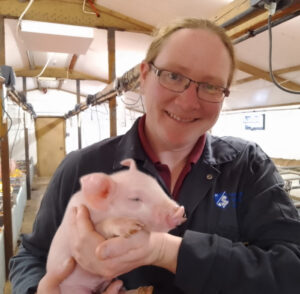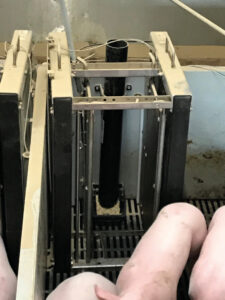[ad_1]
Larger litter sizes are making supplementary feeding an increasingly important aspect of the pig management process. As HELEN BROTHWELL discovered, new research at Harper Adams University has shed new light on maximising the benefits of supplementary milk and creep feed.
UK research is providing vital new insight on how to get the most from supplementary milk and creep feed for improved lifetime performance of pigs – offering economic solutions to the challenge of large litters where there are more piglets than there are functional teats.
Sarah Icely is running the project for her PhD studies at Harper Adams University, alongside her role as deputy sector manager on the university’s commercial indoor pig unit, with funding provided by AHDB Pork, Primary Diets and JSR Genetics.
The key findings are that increasing creep intake is more beneficial to pigs’ post-weaning performance than increasing supplementary milk intake, while the milk has an important role in improving piglets’ pre-weaning survival rates.
Every smaller birthweight pig that survives is an extra pig to sell and therefore helps to improve the economic performance of a business, but these research findings will help producers get the greatest return on their investment in milk replacer and creep feed.
“The trial results are helping us balance the benefits of supplementary milk for piglet survival with adequate creep intakes to prepare piglets for weaning and beyond,” Sarah explained.
The research team used electronic identification to assess each individual piglet’s usage of supplementary milk and creep feed, enabling them to understand much more about the combined effects of supplementary milk and creep feeding and how to get the most from them. The unit had already been using the supplementary milk system for about 15 years to help rear larger litters.
A metal-clad structure incorporating the recording equipment was fixed over the milk cups and the creep feeders in each pen, and the date, time and duration of each visit was recorded against each piglet’s unique ID. “It is set up so it only records when the piglet’s head is actually over the bowl or feeder. We used a single space creep feeder to make sure we had accurate data for individuals whereas we would normally use multi-space feeders,” Sarah explained.
Trial set-up and recording
- Twenty-eight litters of piglets were selected across two batches, farrowing six weeks apart.
- Litters were selected to have two more piglets than there were functional teats on the sows, to model the effect of large litter sizes.
- Supplementary milk was offered from birth and creep feed was offered from day 11 onwards, both ad libitum.
- Piglets were weighed at birth, day four and then weekly up until weaning at day 26.
- Post-weaning, piglets were weighed at days 7, 15, 29 and 54.
- Piglets were each assigned into one of four birthweight groups: 1.04kg and under, 1.06 to 1.52kg, 1.54 to 1.90kg and 1.92kg and above.
- For each visit to the supplementary milk bowl or creep feeder, the piglet’s electronic ID and the length of their visit was recorded automatically
- Results analysis looked at the relationships between total duration of supplementary visits, total duration of creep visits, weaning weight and birthweight group.
Timing is key
Initially, the supplementary milk system was turned off just two or three days before weaning. The team then began turning it off earlier, a full week prior to weaning, to see how much difference it made.
The results showed that when piglets had a full week without the supplementary milk, creep intakes increased significantly, from just over 3kg per litter per week, to 5.7kg per litter, with an average of 14.5 pigs weaned per sow. There were no negative effects on mortality or growth.
Switching off the supplementary milk for a full week before weaning translated to a saving of around 50p per piglet on pre-weaning feed, compared with when the milk was offered until just a couple of days before weaning – taking into account both milk and creep costs.
The research found that the vast majority of piglets will find and use the supplementary milk bowl during the first day. “They’re naturally adventurous and find it while they’re exploring the pen,” said Sarah. “We’ll just give extra attention and show the milk bowls to any very small piglets who need it.”
There was no effect of suckling position on the average number of visits to the milk cups among piglets with a teat. However, piglets without access to a teat visited the milk cups more frequently and for longer periods of time from day four to weaning, reinforcing the importance of offering supplementary milk from birth.
Interestingly, birthweight didn’t have a significant effect on supplementary milk usage until the last week it was available. “In that final week, it was actually the bigger piglets using the supplementary milk more, as a top up to satisfy their appetites,” Sarah explained.
Creep usage patterns
Similarly, piglets without access to a teat also tended to use the creep feeders more than other pigs and, in the last three or four days before weaning, the heavy birthweight pigs were using the creep more than the low birthweight pigs.
But there was not a lasting relationship between piglet birthweight and daily gain: after day seven, birthweight group ceased to be a significant factor.
An important benefit of offering supplementary milk and creep feed as alternatives to sows’ milk during the pre-weaning period are that piglets develop greater independence from day one. It is good preparation for weaning for the whole litter, Sarah said, and means smaller piglets are often less reliant on the sow than some of the bigger pigs.
Post-weaning performance
Higher supplementary milk usage had a positive impact on piglet average growth rate from birth to day 15 post-weaning.
Higher creep usage had a much longer lasting positive effect on pig growth rates – from weaning until day 54 post-weaning, even though high creep consumers were generally lighter at weaning.
“In the first week post-weaning, the FCR of piglets which had eaten more creep was a lot lower than those with lower creep usage, suggesting they adapted better at weaning,” said Sarah.
Next steps
Having investigated the impact and different benefits of supplementary milk and creep, the next stage of the PhD aims to understand why creep, in particular, is beneficial for the piglet’s longer-term performance. “We want to see what’s happening physiologically, to the pig’s metabolism and physical gut development,” Sarah explained.
This work is in the early stages, with blood sampling underway to analyse the blood metabolites present and see if there are any significant differences between pigs. “This might help us work out how to further support the pigs through dietary composition and creep intakes to get the best out of the pigs,” she said.
Sarah has recently been trained in the histology labs at Harper Adams, where she will working with the lab team to make up slides using sections of the piglets’ gut lining and studying them under a microscope to identify any physical development differences.
The research will also look at the impact of feeding different post-weaning diets according to pigs’ levels of creep consumption pre-weaning.
In future, there is also potential to see whether the length of time the supplementary milk is offered for can be refined further for optimal creep intakes.
Managing supplementary milk systems
As well as removing the supplementary milk early enough to ensure adequate creep intake, other key practical recommendations from the research include:
- Get all piglets drinking from the milk cups from birth, showing them where the cup is if needed, particularly the small ones.
- Clean milk tanks and make up fresh milk daily so it is palatable and fresh.
- Provide as much milk as piglets will drink for the full three weeks.
They plan to replace the supplementary milk system on the Harper Adams University unit, hopefully in the next 12 months. There are plenty of options available, from the basic, manual to automatically controlled systems that mix up fresh milk to meet demand.
Small pig management on the unit also includes carrying out night checks during farrowing, split suckling and bottle-feeding colostrum to any piglets weighing less than a kilo – followed up by the ad lib access to creep.
[ad_2]




